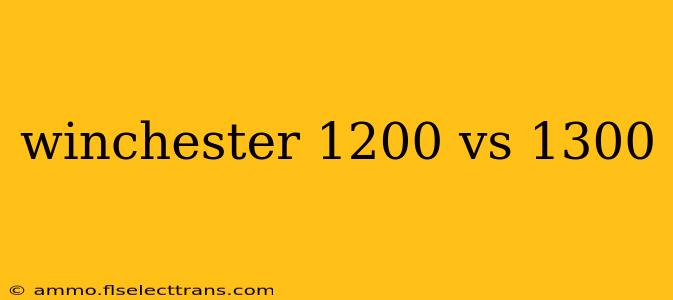Choosing the right shotgun can be a daunting task, especially when comparing similar models from reputable brands. Winchester's 1200 and 1300 pump-action shotguns are both popular choices, but understanding their key differences is crucial for making an informed decision. This in-depth comparison will analyze the features, performance, and overall value of each model to help you determine which best suits your needs.
Design and Construction: Subtle Differences, Significant Implications
Both the Winchester 1200 and 1300 are built with reliability in mind, employing durable construction to withstand the rigors of hunting and shooting sports. However, there are subtle differences in their designs:
-
Receiver: The 1200 features a forged steel receiver, known for its robustness and longevity. The 1300, while also sturdy, utilizes a cast receiver, which, although generally reliable, can be slightly lighter. This difference in receiver material subtly impacts the overall weight and feel of the shotguns.
-
Action: Both shotguns operate on a smooth pump-action system, delivering consistent cycling. However, some users report a slightly smoother action on the 1200 due to its forged receiver and potentially tighter tolerances.
-
Finish: Both models offer a variety of finishes, including durable synthetic stocks and wood options. This choice largely depends on personal preference and intended use.
Performance and Handling: On the Range and in the Field
The performance of both shotguns is largely comparable. Both the 1200 and 1300 reliably cycle a wide range of ammunition, from light target loads to heavier hunting rounds. However, subtle differences exist:
-
Recoil: The slight weight difference between the two models, mainly due to the receiver material, can affect felt recoil. The heavier 1200 may offer slightly less perceived recoil for some shooters, particularly with powerful loads.
-
Balance: Balance is a subjective aspect but often depends on the specific barrel length and stock configuration. A careful evaluation in hand will be necessary to determine which feels more balanced for your shooting style.
-
Accuracy: Accuracy depends largely on the shooter's skill and ammunition used, rather than significant differences between the 1200 and 1300. Both are capable of accurate shots within their effective range.
Features and Options: Tailoring to Your Needs
Both the 1200 and 1300 offer a range of barrel lengths and configurations to cater to different shooting disciplines. Consider these features when making your choice:
-
Barrel Length: Available barrel lengths range from shorter options ideal for home defense to longer barrels suited for hunting and sporting clays. Choose a length appropriate for your primary use.
-
Choke Tubes: Both shotguns generally accept interchangeable choke tubes, allowing you to adjust the shot pattern for various shooting situations and target types.
-
Stock Styles: A variety of stock types are available, including synthetic and wood options, offering choices for comfort and handling preferences.
Winchester 1200 vs. 1300: The Verdict
Ultimately, the choice between the Winchester 1200 and 1300 depends on individual needs and preferences. The 1200, with its forged steel receiver, might be preferred by those prioritizing robustness and a potentially smoother action, even if it comes with slightly higher weight. The 1300, meanwhile, offers a potentially more affordable option with a lighter overall feel, which might be advantageous for certain applications.
Thorough hands-on evaluation is essential. Visit a local gun store, handle both models, and consider which fits your hand and shooting style best. Weigh the subtle differences in features and performance against your budget and intended use to make an informed decision. Remember to always prioritize safety and responsible firearm handling.

